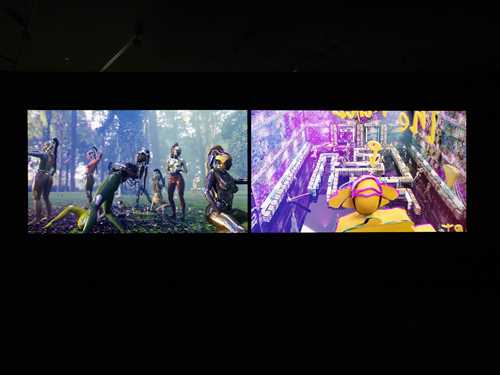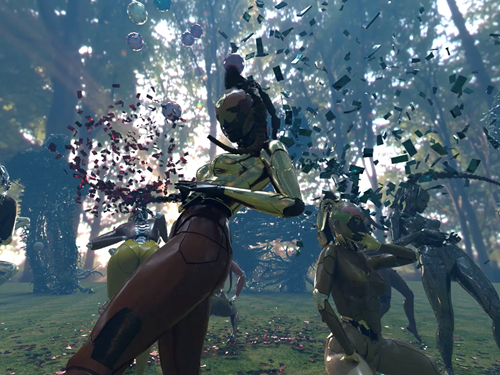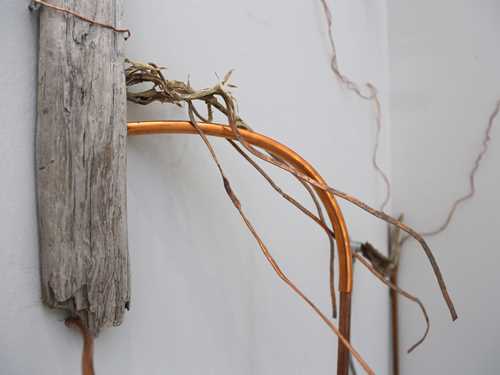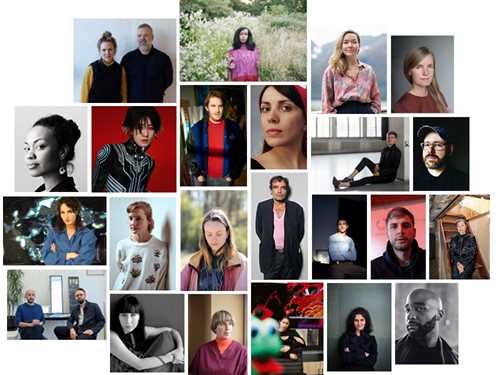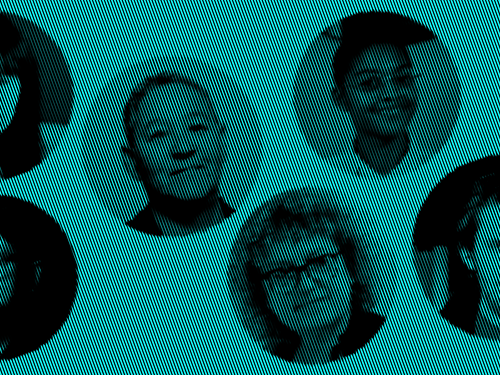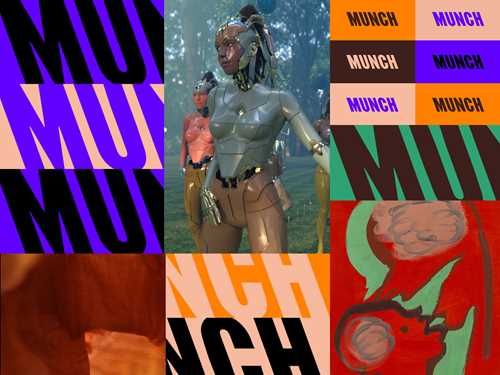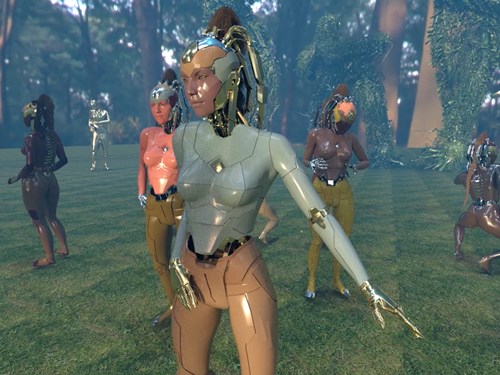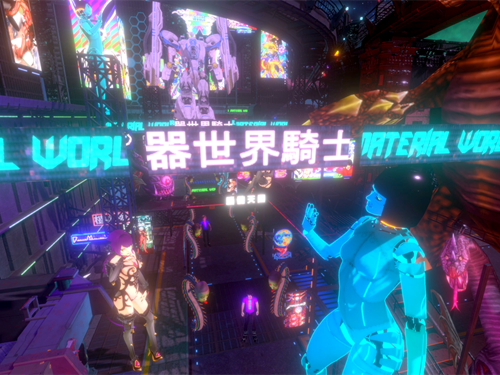The Machine is Us
Curator Tominga O’Donnell outlines some of the themes that emerge in The Machine is Us. The exhibition features 25 artists exploring society’s digital transformation using fresh perspectives and subversive approaches.
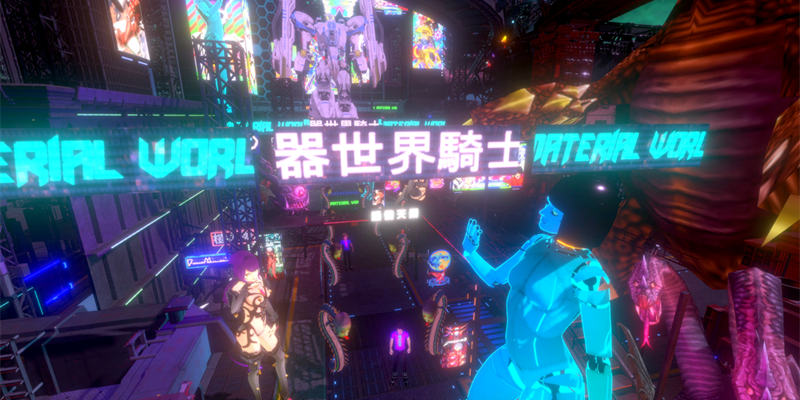
Ly Yang: The Great Adventure of the Material World, 2020. Courtesy of the artist
A museum triennial is more than a traditional group exhibition. In addition to being a recurring format with the promise of a subsequent edition in three years’ time, the MUNCH Triennale is a site of contemporary artistic production, where artists are invited to develop new projects. Consequently, almost half the works in the Triennale are commissions, which sit alongside existing artistic production from recent years.(1) The expectation of newness or ‘recentness’ from a museum triennale might pose a challenge to an exhibition that has been delayed for almost two years due to the global pandemic and the subsequent late opening of the new museum building. Nonetheless, as curator of this exhibition, I would argue that the works in it have lost none of their relevance. The advantage – and challenge – of collaborating with artists on developing new works is that they can be altered right up until the public opening. Some of the commissions have, therefore, changed while the project was on hold, whereas others have taken on renewed significance. After all, most people’s existence has become even more entwined with machines as a result of social lockdown conditions.
Cyborgs, Glitches and Queer Potentiality
This first edition of the Triennale takes its title from Donna Haraway’s A Cyborg Manifesto from 1985, which contains the following quote: ‘The machine is not an it to be animated, worshipped and dominated. The machine is us, our processes, an aspect of our embodiment.’(2) I was reminded of this sentiment when I stood in line for airport security behind a teenage boy, who had put all his possessions in the tray to be X-rayed and was surprised to discover that his phone was deemed separate from his body as the alarm went and he was pulled aside. For his generation – and many others – the phone is not a discrete object, it is fully part of who you are; a corporeal extension of that leaves a gaping hole when removed. The distinction between online and offline no longer applies. In Glitch Feminism – A Manifesto, curator and writer Legacy Russell proposes the acronym AFK to describe the temporary absence of the digital native of being ‘away from the keyboard’. In the conception of the exhibition, the curatorial team have sought to bring together works that transcend any artificial division between humans and the digital devices that increasingly permeate our lives.(3) In fact, it is in between these two that some of the most interesting things can happen.
Inspired by queer methodologies, the curatorial premise of The Machine is Us has asked ‘what if?’ in the sense of ‘what could be’ or ‘what is the alternative’ after Jose Esteban Muñoz’s definition of queerness as a horizon, ‘a longing that propels us onward, beyond romances of the negative and toiling in the present’.(4) The way I define ‘queer’ is not limited to issues of sexual orientation, but rather refers to a critique or rupture of an existing order that is not only heteronormative but misogynist, white, anthropocentric, traditional in its values, conservative in its approach to artistic disciplines and disciplining. In short, a queer approach entails considering the other – the alternative that has been othered – by the dominant social order. This suffuses all my work, and with a curatorial team consisting of different people, the curatorial approach in this exhibition has been expanded to incorporate different points of view and other specialist interests. What united us, though, and what has provided some kind of roadmap in our mapping of hundreds of artist’s practices was to seek out a sense of playfulness – even with serious subject matter. This celebration of joy, even in the midst of struggle, is a fundamentally queer strategy and one that I hope also has characterised our collaborations with the artists in the Triennale.
Russell sees great potential in societies’ digital transformation, writing that ‘Through the digital, we make new worlds and dare to modify our own’.(5) This positive possibility of digital communications applies particularly to bodies and identities that have traditionally been marginalised in mainstream media and social spaces. Inspired by cyberfeminism, the internet can offer community, validation, and resonance for explorations in subject formation, which can then be taken AFK and back online again in a constant loop. Agency, for Russell, resides in her notion of the glitch, where normative bodies, behaviours and binaries can be transcended much faster than a traditional off-line world, which social movements such as Black Lives Matter or MeToo are testament to. However, such a hopeful outlook on the potential of social media can be tempered by what artist and writer James Bridle refers to as a ‘new dark age’ in his book of that name, subtitled Technology and the End of the Future. Here, systems we no longer understand dominate us, imposing digital imperialism, algorithmic bias, invasive surveillance and social manipulation. In addition, data centres require a huge amount of energy and have about the same carbon footprint as the airline industry.(6) Even in a country like Norway, with its hydroelectric power and access to cooling water attracting large computational service providers, energy has become a scarce and expensive resource. If Russell and Bridle can be located at either end of a utopian/dystopian spectrum when it comes to new digital technologies, most of the artists in The Machine is Us can be located somewhere in between, often encompassing both perspectives. There are works in the exhibition that appear playful and humorous, but most of them retain a critical edge. There is beauty and political punch, silliness and thoughtfulness, sexiness and seriousness, desire and dread.
Making Worlds
The notion of world-making – of using digital tools to transcend the limitations of the present – is central to a number of artists’ work, including Jacolby Satterwhite’s fantastical landscapes where fabulous cyborg figures in futuristic outfits dance and cavort to a pulsating soundtrack of electronic music with vocals by the artist’s deceased mother. Lu Yang similarly uses the aesthetics and the form of video games to create settings where the players step into alternative universes where gender norms are suspended and they can form alliances with characters from the artist’s earlier works. Meriem Bennani has created the entirely speculative environment of CAPS – an island where teleporting migrants have been stopped mid-transfer and held indefinitely, and a friendly cartoon crocodile greets new arrivals.
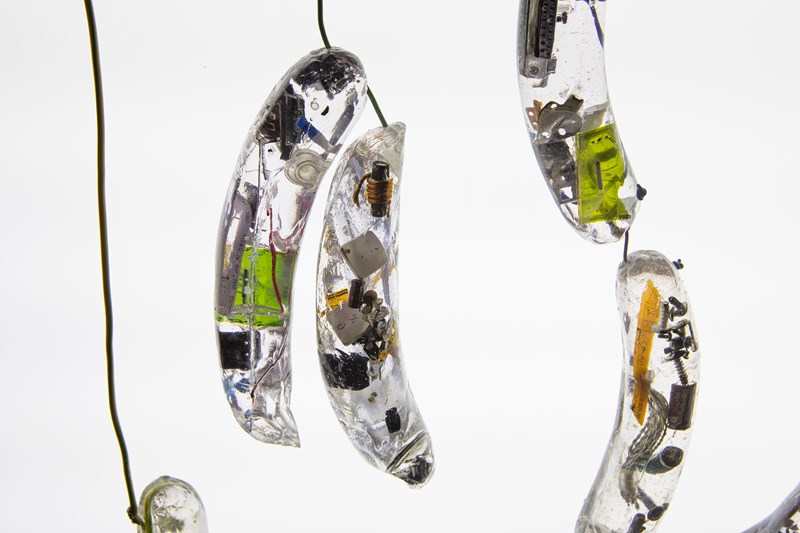
Photo: Munchmuseet
Speculations on new worlds with a queer perspective, which Liv Brissach discusses in her text, are also evident in Gillian Brett’s work, though the form is three-dimensional as she makes fast food for machines in the future – kebabs and sausages made of the debris of defunct technology, set in transparent resin.
Old and New Technologies
Yang’s video game is juxtaposed with one of the artist’s paintings, and many of the works in the exhibition bridge so-called old and new technologies. Cory Arcangel uses a Twitter bot to create a score for the carillon bells in Oslo City Hall, a medieval form of public announcement; Agnieszka Kurant’s NFT assumes material form as it is redeemed in a sculpture made from the ground-up remains of different kinds of historical currency – from coins to whales’ teeth. Zach Blas reimagines the well-established format of the religious sermon in a scenario where God is an AI, while Salome Asega uses the monster truck as a starting point for discussion on algorithmic bias in the application of risk assessment tools (RATs).
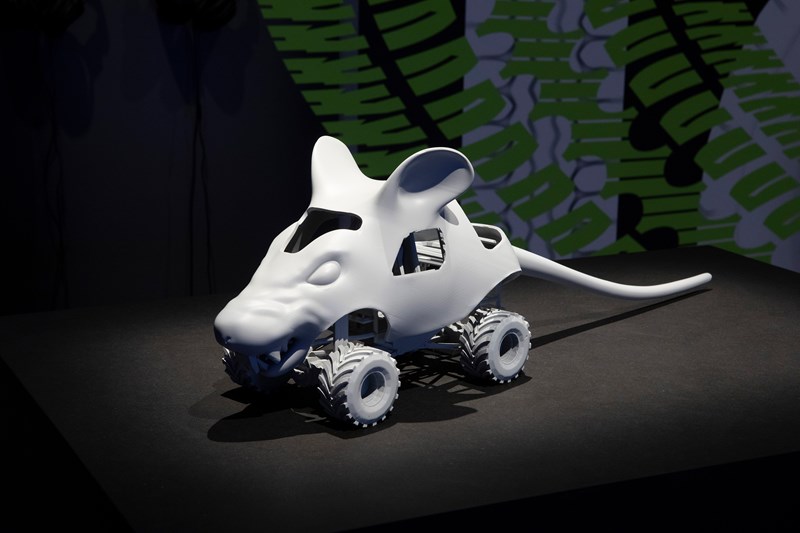
Photo: Munchmuseet
The acronym is playfully evoked in her giant automobile rat – reproduced as both a 1:1 photograph, a 3D print and an AR-work. The soundtrack of leading thinkers discussing the impact of algorithms that use biased datasets provide a grave juxtaposition. This balancing act between the deadly serious and the playful is also evident in the three-channel video installation by Hito Steyer, Giorgi Gago Gagoshidze and Miloš Trakilović. Here, the three artists depart from the collapse of the Soviet Union and the ensuing privatisation and fragmenting of Communist identity, and show how the aesthetics of war-time poverty are mined by fashion-houses like Balenciaga for enormous profit. Such exploitation of user-generated content is also an aspect of Agnieszka Kurant’s work in The Machine is Us, which Vilde Horvei discusses in her text. In order to create her aforementioned NFT, Kurant collaborated with computational social scientists who used Artificial Intelligence sentiment-analysis algorithms to harvest data from hundreds of thousands of Twitter and Reddit posts related to recent socially seismic events, such as the Fukushima nuclear disaster, the Arab Spring and other social movements, the pandemic global lockdown, and meteoric rise of cryptocurrencies. Describing tweets, shares and likes as ‘the new oil and gas’, Kurant draws a link between digital capitalism and geology, where people’s sentiments are as profitable to mine as precious metals.
Processing Information
One of the things artists are particularly adept at is creating visual representations of concepts that evade capture by language. Silje Linge Haaland has developed a fragmentary image of information overload in her installation, where she likens her video to an ‘eye stammering’. In her new work for The Machine is Us, Helle Siljeholm has created an installation that represents a blockchain network with wooden sticks, donated to her from all over the world, and reclaimed metal from a scrap yard on the outskirts of Oslo. In their site-specific glasshouse installation just outside the museum, in which computers generate heat for tulips to grow, Ayatgali Tuleubek and Michael Rahbek Rasmussen evoke the toll that data mining takes on the environment. Using tarot readings to determine whether to buy, hold or sell actual shares on the Oslo Stock Exchange, Tuleubek and Rasmussen also demonstrate the speculative nature of trading. Working with the latest video game technology, Cameron MacLeod and Magnhild Øen Nordahl have recreated the view from inside the museum to the west onto a pre-civilisation landscape in virtual reality. By moving the rocks in the installation, visitors can change the time of day, the season and the weather, much as humans have done in the anthropocentric era.
Nature / Culture
Many of the works in The Machine is Us assert a link between technology and the natural world. Siljeholm uses the tree as a metaphor for blockchain, created from reclaimed wood and mined metals such as copper. At the entrance of her audio-visual installation, Haaland has placed an old tree trunk inset with sim cards that plays with the relationship between natural memory in the form of the tree’s rings and those from discarded mobile phones. Tuleubek and Rasmussen have insisted that their outdoor installation features living tulips, evoking one of the earliest commodities to be subject to financial speculation in the 1630s, when ‘tulip mania’ resulted in the first recorded example of an economic bubble bursting. Lesia Vasylchenko has devised an artificial sunrise, created by machine learning from over a thousand randomly sourced images of sunrises from her native Ukraine from 1990 to the present day.

Lesia Vasylchenko: Tachyoness, 2022. Courtesy of the artist
The video greets visitors to the museum with its strange, moving, almost pulsating presence on its large screen, powerfully resonating with the many versions of the sun in Edvard Munch’s paintings in the permanent collection on the floors above. While providing an interesting tracing of the developments in image technology from the early 1990s, from pixellated and grainy photographs of sunrises to contemporary high resolution digital imagery, the work has taken on renewed significance since the Russian invasion of Ukrainian territory in February 2022.
Human Hands
What many of the works in The Machine is Us make evident is that human labour still lies at the heart of even the most sophisticated machinery, whether creating realistic VR environments, programming artificial intelligences or creating animations. The late Harun Farocki, who passed away in 2014, was one of the first artists selected for the MUNCH Triennale, and his Parallel I–IV acts as a touchstone for the whole exhibition. This four-part, six-channel immersive installation includes footage of animators at work, revealing the labour involved in producing gaming environments, which was also evident watching MacLeod and Øen Nordahl’s collaborators painstakingly recreating blades of grass, moss and snowflakes for their VR-environment. The emphasis on hands – in her video but also in the hands that have pressed each sim-card into the tree trunk is also evident in Haaland’s installation. Farocki traces how video games have developed from two-dimensional schematic representation to photorealistic settings in just over thirty years. Excerpts from popular video games are accompanied by an essayistic voiceover exploring such topics as the rendering of nature, the possibilities of bodily movement, first-person points of view, and the peculiar physics of the gamespace.
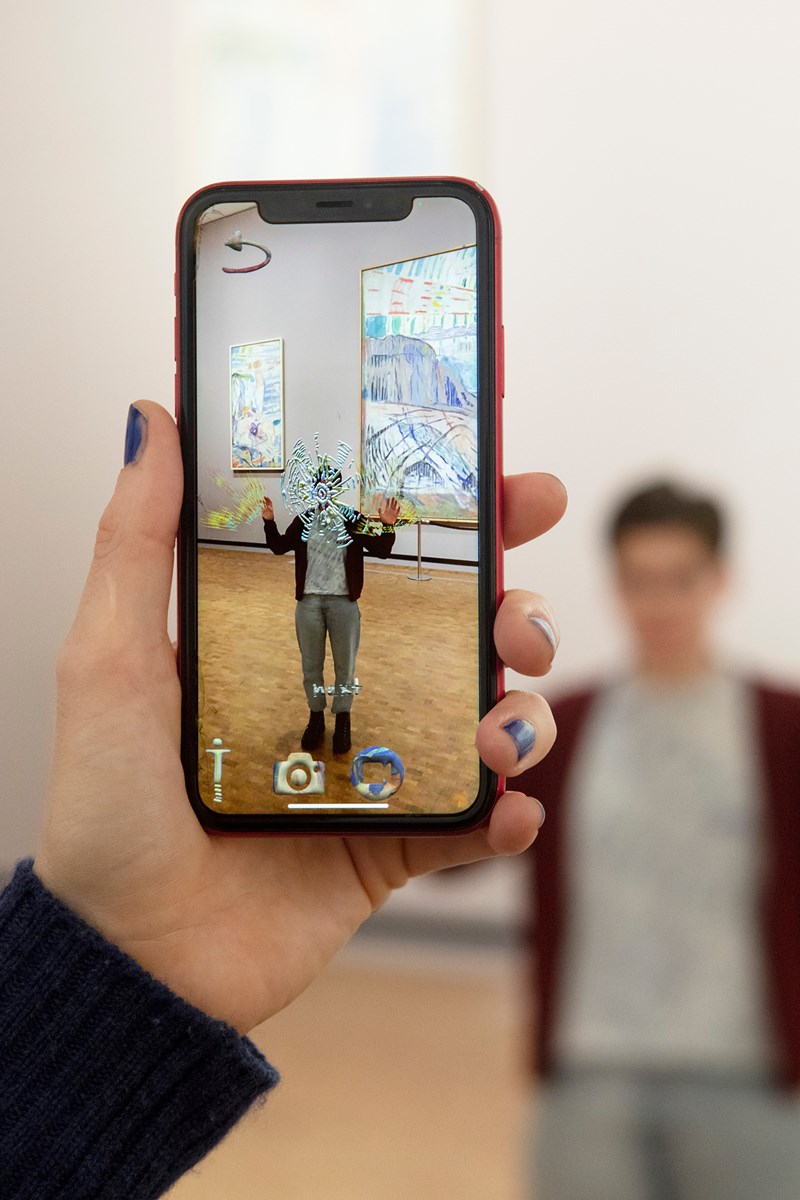
Photo: Munchmuseet
The emphasis on human labour is also evident in the work of Bella Rune, who quite literally explores handiwork in her app-based commission Munch Mani-Cure. It departs from Edvard Munch’s paintings in the museum’s permanent collection, focusing on the the hands as the human tools that made the original paintings, as well as all the labour that goes into restoring and preserving them for the future. Visitors need to move their own hands in order to activate the colour palette in the app.
Whose Image?
In Frieze magazine’s landmark 200th issue, writer Orit Gat suggested that the introduction of the JPEG as a lightweight file format that enabled the fast upload of images ‘facilitated a new shared way of viewing the world’.(7) It also flooded the internet with low-resolution copies of photographs from all around the globe and, what Steyerl has called ‘poor images’.(8) However, it was quickly monetised by large image banks. Maryam Jafri’s video refers to a real-life case where images of the artist’s own work at Frieze Art Fair was acquired by the commercial picture archive Getty Images, and through a misspelling of her name, she was denied access to it, despite owning the copyright to her own artistic creation. Jafri has been working with this problematic for several years, initially with her work Ghana vs. Getty Images, in which she showed how Ghanaians were not given access to images of their own independence celebrations because Getty owned the rights. Jafri’s work is juxtaposed with Frida Orupabo, whose grid of found imagery continues her investigation into colonial archives. Photographs here are often watermarked by image banks – like Getty or Alamy – which, when it comes to historical imagery, often function as a form of double dominion over people’s image rights. Their portraits were captured the first time round without any remuneration or retention of rights, and their descendants cannot use their images without paying a fee to the global corporation that have acquired the rights to use them. By using them in her work and reappropriating them in analogue form for her wall-based paper works, the artist is, in her own words, ‘stealing them back’.(9)
Anti/social Media
Global social networking sites rose to prominence in the early 2000s with Myspace launching in 2003 and Facebook becoming widely accessible in 2006. They have had a profound impact on how humans communicate and socialise with each other – or not. Trolling, ghosting and blocking are all terms that receive new meaning in relation to online behaviour. In the various codes of conduct that fluctuate on the internet, one of the first rules is to ‘remember the human behind the machine’.(10) In her video installation Pilvi Takala does just that, engaging with an online troll that has been harassing her and gradually she humanises her anonymous tormentor. The effect of online dating and social media on interpersonal relationships forms the backdrop for the documentation of Victoria Durnak’s performance in Oslo in 2020. Inspired by a Japanese company that offers ‘humans for hire’, Durnak started her own rental service in Oslo for any kind of person one might feel the need for – a partner, a daughter, a friend. These relationships are transactional but are they any more or less real than the social personas people adopt online and transfer AFK?
Network Thinking
It is common for technological advancements in a certain time period to become an analogy for parts of the human anatomy we fail to comprehend: In the 17th century, René Descartes likened the brain to a hydraulic pump, propelling the spirits of the nervous system through the body, whereas Sigmund Freud compared the brain to a steam engine some 250 years later.(11) In her wall-based work, consisting of eight diptychs of diagrams, Toril Johannessen sketches how her idea of computers has shifted since she was a child. Imaginary Networks starts in 1991 and continues until 2026. The schematic drawing of how she thought of computers is juxtaposed with how she conceived of the human brain at the same points in time. The diagrams are accompanied by small snippets of text and the series is imbued with both a sense of nostalgia for a simpler time and the visual realisation that the distinction between the brain and the computer is collapsing. The exhibition also includes references to those left behind by technological developments, such as the elderly woman in Gagoshidze’s other video in the exhibition, who is charged with cyber-terrorism when she accidentally cuts a main fibre-optic cable while scavenging for copper in Georgia. The woman has never heard of the internet, and the video is a timely reminder of how the digital revolution, which to some feels like a new ‘normality’, has still not reached all corners of every society.
The current digital transformation has changed how art is made and looked at. It is too great a social change to be summed up in one exhibition, so what The Machine is Us attempts to do is to show artists who have engaged with different aspects of new technologies in playful ways that contribute to different fields of inquiry. Together, the works in The Machine is Us weave a meandering tale of human ambition, exploitation, and manipulation, but also of beauty, desire, and delight.
Tominga O’Donnell is curator for The Machine is Us.
-
1) Artists contributing new work to the MUNCH Triennale include: Agnieszka Kurant, Ayatgali Tuleubek & Michael Rahbek Rasmussen, Bella Rune, Cameron MacLeod & Magnhild Øen Nordahl, Cory Arcangel, Frida Orupabo, Helle Siljeholm, Lesia Vasylchenko, Lu Yang, Salome Asega, Silje Linge Haaland, Toril Johannessen, Victoria Durnak and Zach Blas.
2) Donna J. Haraway, ‘A Cyborg Manifesto – Science, Technology and Socialist-Feminism in the Late Twentieth Century’ in Donna J. Haraway, Manifestly Haraway (University of Minnesota Press, 2016), p. 65.
3) The curatorial team has shifted in the three years since the Triennale’s initial conception and I have at different times had the pleasure of working with Stefano Collicelli Cagol, Vilde Mortensdatter Horvei, Nora Ceciliedatter Nerdrum, Ilavenil Vasuky Jayapalan, Jon-Ove Steihaug and Liv Brissach.
4) Jose Esteban Muñoz, Cruising Utopia, The Then and There of Queer Futurity (New York University Press, 2009), p. 1.
5 Legacy Russell, Glitch Feminism – A Manifesto (London: Verso, 2020) p. 11.
6) James Bridle, New Dark Age: Technology and the End of the Future (London: Verso, 2018), p. 63.
7) Orit Gat, How the JPEG Changed Everything (February 2019) https://www.frieze.com/article/how-jpeg-changed-everything
8) Hito Steyerl, ‘In Defence of the Poor Image’, e-flux journal, Issue #10 (November 2009) https://www.e-flux.com/journal/10/61362/in-defense-of-the-poor-image/
9) Frida Orupabo to Maya Binyam in ‘Stealing It Back: A Conversation with Frida Orupabo’, The Paris Review, 25 April 2022 https://www.theparisreview.org/blog/2022/04/25/stealing-it-back-a-conversation-with-frida-orupabo/
10) The reference for these various codes is often Virginia Shea, Netiquette (San Rafael, CA: Albion Books, 1994).
11) Gary Marcus, ‘Face It, Your Brain Is a Computer’ in The New York Times, 27 June 2015 https://www.nytimes.com/2015/06/28/opinion/sunday/face-it-your-brain-is-a-computer.html?smid=pl-share
